 There are several definitions of the concept of “Zen”. One that I found recently reads as follows: “Zen is the idea of living fully in the present moment, in order to make each instant of one’s life a peak experience. Each moment is filled with profound peace, relaxation, and clarity. Each moment is perceived to have infinite depth and significance, charged with magic and mystery, infinitely precious.” In the world of modern board gaming, I don’t think I’ve ever come across a game that I would describe as a Zen-like experience. That was until I played Tokaido. On the surface, there just doesn’t seem to be much in the way of rules, game play, or strategy. But what about beneath the surface you ask? Get comfortable, clear your mind, think peaceful thoughts, and read on to find out.
There are several definitions of the concept of “Zen”. One that I found recently reads as follows: “Zen is the idea of living fully in the present moment, in order to make each instant of one’s life a peak experience. Each moment is filled with profound peace, relaxation, and clarity. Each moment is perceived to have infinite depth and significance, charged with magic and mystery, infinitely precious.” In the world of modern board gaming, I don’t think I’ve ever come across a game that I would describe as a Zen-like experience. That was until I played Tokaido. On the surface, there just doesn’t seem to be much in the way of rules, game play, or strategy. But what about beneath the surface you ask? Get comfortable, clear your mind, think peaceful thoughts, and read on to find out.
Tokaido is a game (or “journey”) incorporating board movement, set collecting, and variable player powers. It was designed by Antoine Bauza, for 2 to 5 players, and takes about 45 minutes to play (or “experience”).
Game Overview:
In Tokaido, the players take on the roles of ancient travelers, following the historic Tokaido road throughout Japan, from Kyoto to Edo (Tokyo). Their goal is simply to have the most rewarding experiences along the way, by making stops that let them collect souvenirs, relax in hot springs, encounter interesting characters, take in amazing panoramic views, donate to temples, and sample the local cuisine. Several of the actions the players may take involve some sort of set collection, presented in different ways. Once all of the travelers arrive at the final destination on the road (the inn in Edo), the game is over; the player with the most experience points is the winner.
Game Components:
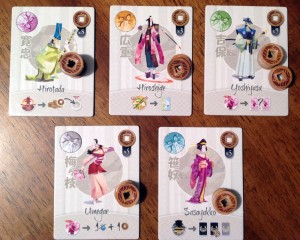
The game board represents the Tokaido road, where the players will stop at chosen spaces to take various actions. There are several sets of cards corresponding to some of those actions (Souvenir, Hot Springs, Encounter, Panorama, and Meal), which are placed on the board. Two small stacks of Achievement cards (awarding endgame points) are placed at the side of the board. The players each take a traveler meeple in their color and place them randomly in a row at the first road space, which represents an inn in Kyoto. They also place their color’s scoring marker at the start of the score track. Each player then chooses, randomly or through a draft, one of several traveler tiles, places it in front of them with a color token to identify their traveler. Each traveler has its own unique special ability. Finally, players take coins in the amount shown in the upper corner of their traveler tile.
How to Play:
Each player takes turns moving their traveler forward any desired number of spaces to an empty space, and takes the action there. However, here’s the catch regarding movement: the player whose traveler is farthest behind on the road gets to take the next turn. Therefore, player order is not done in the usual clockwise order, but instead is always determined by who is in last place along the road. This means that a player may be able to take more than one turn in a row, depending on the positions of the other players, and the spaces he chooses to stop at. Normally, only one player is allowed to stop at a particular action spot, but some spots have two player spaces. In a 4 or 5-player game, up to two players can stop there at the same time. Each road space bears a symbol identifying which action the player takes:
• Village: At this space, the player collects Souvenir cards that belong to one of 4 types (Art, Clothing, Food, and Small Objects). The goal of the player is to collect sets of as many different types as possible. Points earned can range from 1 (for a single card) to 7 (for a complete set of 4 cards of all 4 types). Players can collect multiple sets, which will all score separately.
• Farm: At the Farm space, the player simply collects 3 coins from the supply.
• Hot Springs: At this space, the player draws a card from the Hot Springs deck (worth either 2 or 3 points) and adds it to his collection.
• Temple: At the Temple space, the player may donate between 1 and 3 coins to the Temple, by placing them on the designated space for his color in the Temple area of the board. These coins remain there throughout the game, and score the player 1 point for each coin donated. At the end of the game, the donations of each player are ranked and earn extra endgame points depending on that rank.
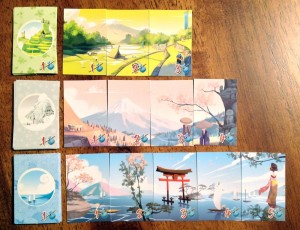
• Panorama: There are 3 decks of Panorama cards, each containing sections of a specific panorama view (Mountain – 3 sections, Rice Paddy – 4 sections, and Seascape – 5 sections). The object here is for the player to collect all sections of a Panorama (3, 4, or 5 cards). He scores the points shown on the Panorama cards he collects. He also takes the corresponding Panorama Achievement card (earning more points), if he is the FIRST player to complete one of the Panoramas.
• Encounters: At this space, the player draws an Encounter card, and applies the effect shown on it. These effects range from earning extra points or coins, to being able to draw an extra Souvenir or Panorama card.
• Inns: The Inns (3 during the journey and 1 at the end of the road) are special spaces, in that all travelers must stop at each one. Each Inn has spaces to hold all players in the game, and as each player approaches an Inn, they must stop there and wait for all players, before moving on. When the first player reaches an Inn, he draws as many Meal cards as there are players, plus 1. He then looks at them (without showing the others) and may purchase one of them, by paying the cost. A player may only buy one of each type of Meal card during the game, and each one is worth 6 points. As the other players reach the Inn, they may buy one of the remaining Meal cards drawn by the first player. Once all players have arrived at an Inn, they all may then continue on the road.
During the game, the players may use the ability on their traveler tiles whenever appropriate. These abilities include: discounts on the costs of various cards, extra points for taking certain actions, and other rules-breaking abilities.
Once all players have arrived at the last Inn on the road (Edo), and (possibly) purchased a final Meal card, the game ends with a few final scoring opportunities. The 4 general Achievement cards (Gourmet, Collector, Bather, and Chatterbox) are awarded to the appropriate players. The Temple donations are then scored (as described above). The player with the most experience points wins the game (and will most likely go off somewhere and meditate on his victory!)
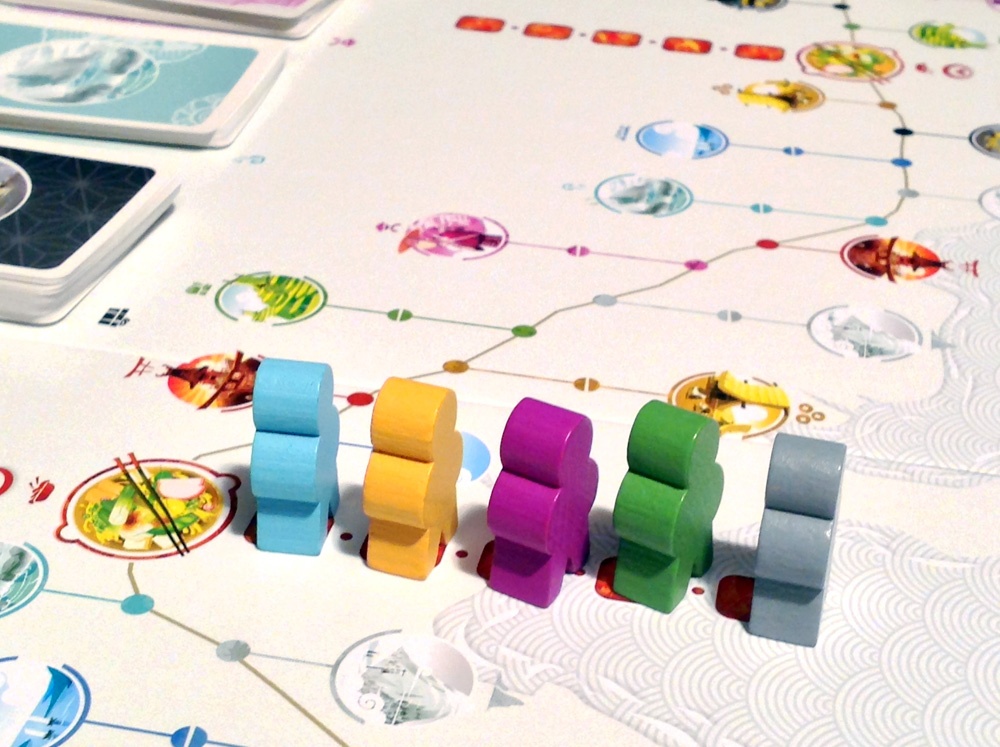
Game experience:
The first time I read through the game rules, I have to say that I wasn’t too impressed. But even though the rules are simple, and you aren’t supposed to be doing much more than moving along the road peacefully and taking whatever actions you come upon, there is still a good amount of strategy needed if you want to become the winning Zen master. First and foremost is the movement rule, with the player in last place being able to take the next turn.
In the gaming geek world, this mechanism is known as a “time track”. I have encountered this mechanism before, in the games Glen More and Thebes. I really enjoyed the strategies in dealing with this mechanism in those games, and I liked it here as well. If you are constantly making big moves, jumping over the other players, you can get to certain spaces first (which can be an advantage), however, you’ll spend more of your game time waiting for the other players to pass you on the road, before you get to take your next turn.
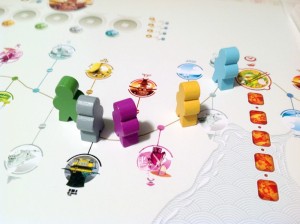
On the other hand, if you concentrate on making small movements, always staying in the back of the pack, you’ll take more turns, but possibly have fewer choices at some of the spaces, or miss opportunities to be the first to complete the various Panoramas. I like games that hand you these frustrating core choices.
Also, although the theme of the game is all about having a peaceful, relaxing journey, there can be some real nastiness hiding under the surface. Again, this comes in the movement choices. If you know what space an opponent is going for, and you have the opportunity to get to that space first and deny it to him, why not? Take that, Zen boy! I have played this game with both adults and children, and I wasn’t surprised at the kids picking up the rules easily, but I was surprised on how easily they grasped the “take that” opportunities, and I think that made them enjoy the game even more because of it!
The artwork is very thematic, and pretty awesome, in my opinion. Overall, the components are average to above-average quality. However, the score markers (at least in my copy of the game) were tiny round discs, not much larger than an aspirin tablet, and they were difficult to pick up and maneuver, almost to the point of being unusable. Everyone I’ve played with agreed with me on this point.
Final Thoughts:
Even though I enjoy this game, and I’ve already taught it several times to new players, I honestly don’t see how often it will get to my gaming table. There are definitely a lot of meatier games out there that use the same mechanics, and I would most likely opt to play one of those over Tokaido, if given the choice.
That said, there’s nothing wrong with using this game as a filler, or for starting up or winding down your game night. In the interest of full disclosure, there is a “collector’s edition” of the game being released later this year, with expansions, more elaborate components, and even unique miniatures for all the travelers. I have this edition on pre-order, and I’m looking forward to receiving it, because the collector in me demands it. In closing, if you’re the sort of gamer who likes a little Zen with your strategy, you don’t have to look any further than Tokaido.
If you are interested in getting a copy for yourself, it’s about $33.
Final Score: 3.5 Stars – An easy-to-learn set collection game, which can be as peaceful or as nasty as the players allow it to be.
 Hits:
Hits:
• Easy to learn, even for kids. Could be a good choice for a gateway game.
• The time track mechanism forces you to make some tough choices.
• Great artwork, very evocative of the theme.
Misses:
• Might not be satisfying enough to the more hard-core gamers.
• The scoring markers could have been made a little larger.




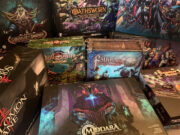




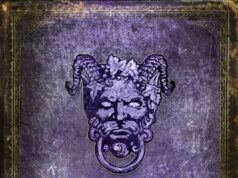

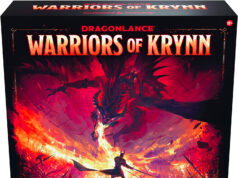











9.5 years later, how is the Collector’s Edition compare?